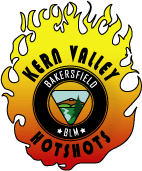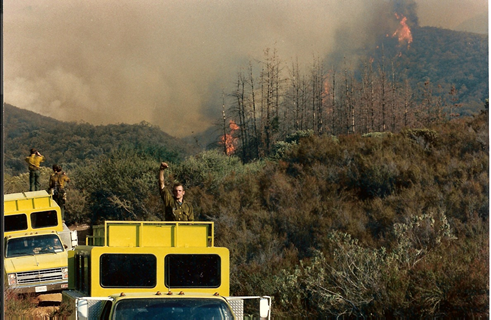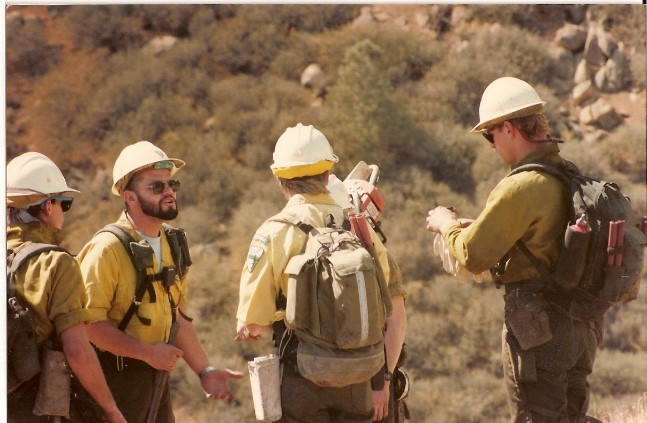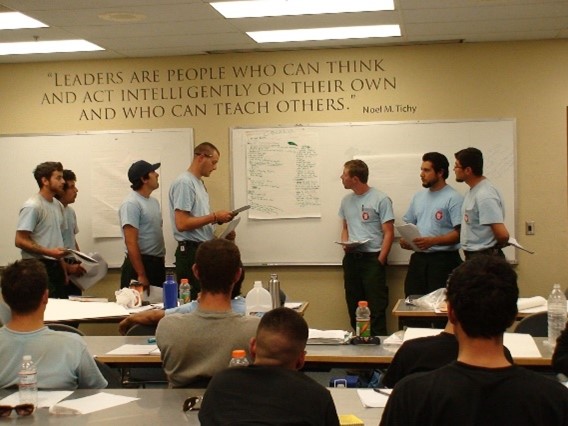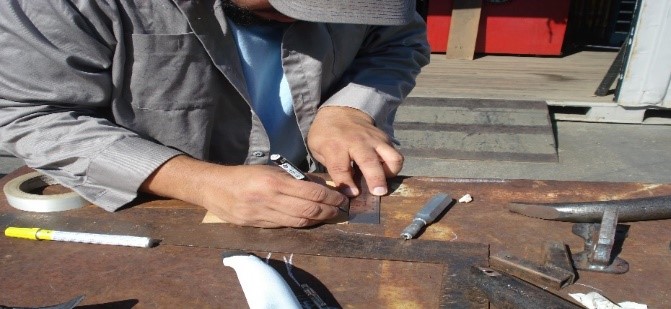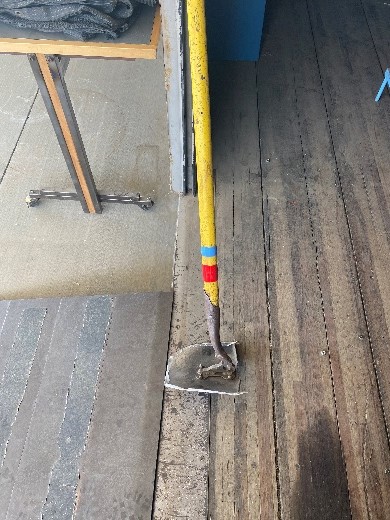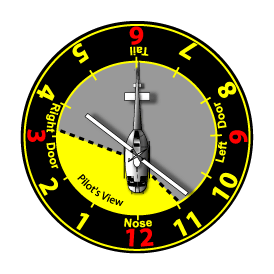About Us
The Kern Valley Interagency Hotshot Crew is stationed at the Bureau of Land Management Field Office in Bakersfield, CA. KVHS is a national resource on call to fight fires anywhere in the US. Kern Valley is an elite 20-person handcrew that fights wildfires with chainsaws, hand tools, and fire. The crew was founded in 1983 as the first BLM hotshot crew in CA. Here at KVHS, performance drives everything. The tradition is continuing to challenge and develop leaders/firefighters, the KULCHA, physical fitness, and continual training in fireline skills and leadership.
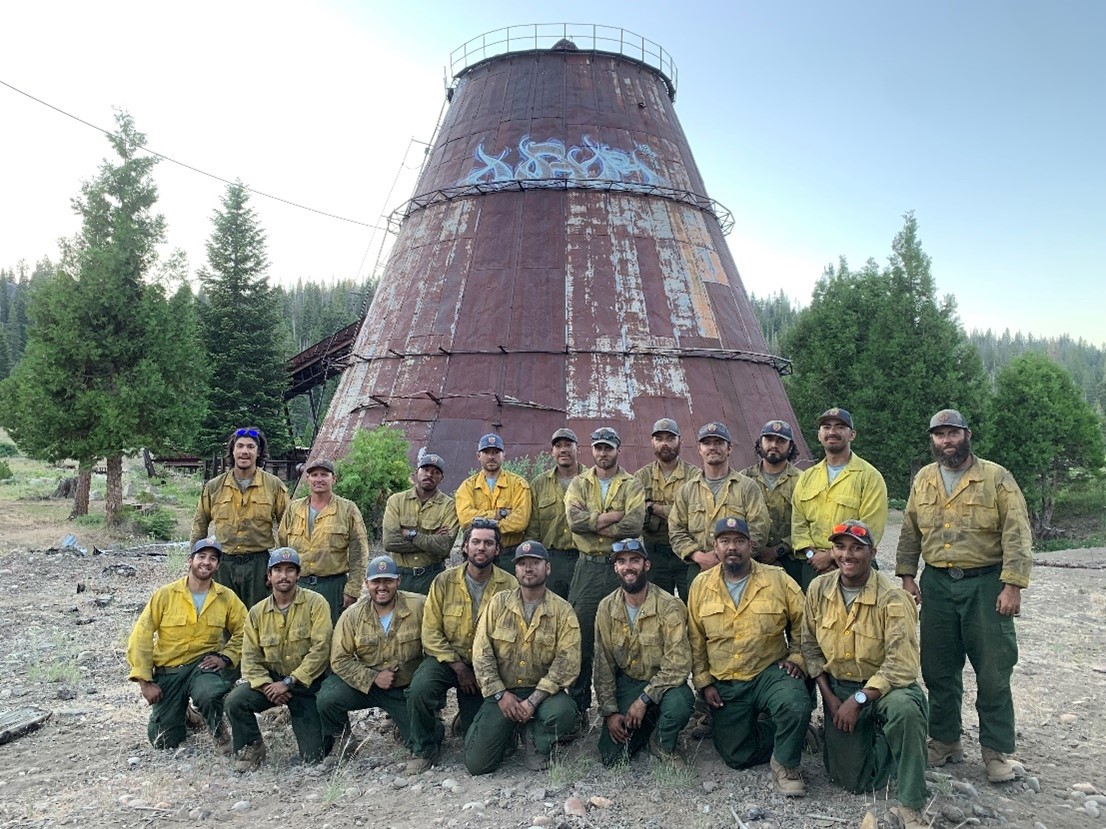
Mission statement:
The mission of the Kern Valley Hotshot Crew is to hire, develop, and retain fit, motivated, high performing individuals, equip them with the best tools and training available, and execute line construction operations with remarkable precision, speed, and efficiency.
In support of our mission:
- We will train relentlessly, engage in ongoing leadership development and recognize and capitalize on opportunities to innovate.
- We will work as a crew (team) to remove fuels and connect existing barriers around the fire and hold it.
Kern Valley Leadership Values and Behaviors
- Duty - Communicate clearly, utilize LECS systematically, practice human factors knowledge, and practice leadership at all levels
- Respect - Live a physical life, develop yourself as a firefighter, develop a KULCHA of hard work, follow through on commitments.
- Integrity - Embrace the reporting KULCHA, take pride in your work, don’t take shortcuts, and stay engaged.
History
Much of the credit for the formation of the Kern Valley Interagency Hotshot Crew lies with former Bakersfield District FMO Rick Haffenfeld. Rick viewed having a hotshot crew on the district as a solution. He started the process of putting together a crew. He began with the selection of a Superintendent. Rick’s quest to find the right person for the job took him to the nearby Los Padres National Forest. In the spring of 1983, a 26 year old Anthony Escobar reported for duty.
The crew was initially a collection of BLM and Forest Service firefighters known as Crew 6 who worked out of the Blackrock Work Center on the Sequoia National Forest. In 1985 the crew moved to the Chimney Peak Fire Station, Anthony became a BLM permanent employee, and all the crewmembers were now strictly BLM. “The Peak” as it was known consisted of three large trailers and a mess hall. The station was powered by generators and lacked phone service. The crewmembers stayed in small two-person travel trailers situated uphill from the station. The 1985 fire season was busy, and several large fires burned in Southern California. During the Wheeler Ridge fire near Ojai the crew was able to turn the corner on a key piece of line enabling containment of the 180,000-acre fire. Anthony regards this fire as the seminal point when the crew became a hotshot crew. At this time there was no formal process for certifying hotshot crews. Through informal peer recognition by the R5 hotshot crew superintendents present, the crew was a hotshot crew. The crew would come to be designated as Crew 1, the Kern Valley Interagency Hotshot Crew.
The Kern Valley Hotshots have had a total of 5 crew superintendents. There is only one contiguous version of the Kern Valley Hotshots. The initial approach, lessons, values, and work processes simply continue to be improved and refined to meet new challenges.
Crew Superintendents
- Anthony Escobar - 1983-2000
- Ron Napoles - 2001-2009
- Leif Mathiesen - 2010-2017
- Nathan Nelms - 2018-2020
Training and Development
Kern Valley IHC puts a huge emphasis on training our crewmembers and in the development of new courses, training methods and techniques to create effective leaders and to answer the basic question of “How do we get more chains on the ground?”
To develop effective leaders, the Crew facilitates multiple Tactical Decision Games (TDG’s) to build our crewmember’s decision-making skills by building mental slides that they can reference in real life scenarios. By putting crewmembers in leadership roles while on assignment, this gets them out of their comfort zone, as we mentor and train them for their next step in their careers. In doing so, we develop capable, effective and confident leaders.
To help better prepare those up and coming leaders, the Crew puts on various courses and classes. One class that we find not only indispensable but crucial, is the Entrapment Avoidance and the Dead Man Zone (DMZ) which we had a hand in helping develop back in 2003. Staying true to our training and development mentality, the Crew dedicates each workday to a certain theme.
Saturday: Training to work on our skills
Sunday: Drills by conducting field exercises
Monday: Projects spurred by innovation
Tuesdays: TDGs to encompass Leadership
Wednesday: Teaching prep where crewmembers have a chance to prepare for their class or course that they will teach or help teach at a later date.
In addition to the training courses that we teach and are helped taught by the crewmembers themselves, throughout the years we have developed our Saw Program and Scrape Program to answer that basic question, “How do we get more chains on the ground?”. The Crew has broken down, analyzed and developed a teaching and training method that turns good scrapers and cutters into great ones through our “Sweet 16” scrape drills and our “Outside In, Bottom Up” cutting technique.
Innovation and Problem Solving
Innovation and problem solving is an important piece of the crew’s program. The driving force behind it is a simple question. How do we get more chains on the ground? During the early years Escobar was faced with many challenges that required him to think outside the box and problem solve. This laid the foundation for the crew’s approach to everyday challenges.
Early innovations included finding ways to make our hand tools better. The Crew built, Super P’s, and Bosely’s and made various attempts at designing other hand tools. A “break-down,” pullers tool was made as well as another tool adapted from the Bosely mechanism. By 1992 the Crew was completely outfitted with fiberglass Nupla handles in its tools. The Nupla epoxy made it possible to attach an array of metal mechanisms to a tool handle. Anthony utilized his body shop background and his father’s input to set up the metal shop and design tools. The crew currently uses what is called the Y-Tool. It is the perfect tool for our local response area.
During a time when Hotshots were relying on hand tools and saws to put out fires instead of utilizing water like the engines did, Anthony in 1985 saw an opportunity to try something new. He decided that the Crew could benefit from carrying a little water with them. Kern Valley was the first to carry water and pumping capabilities on the Supt truck. On the Wheeler Ridge fire Anthony and Luis Yazzie of the Dalton Hotshots utilized the pump to keep numerous houses from burning.
Since 1996 the Crew has worked on developing a specific After-Action Review that focuses on the things that we can learn from during each shift out on the line. The current version Highlights three main topics which are Performance, Safety, and Decision making. After every shift each crew member has the opportunity to share their story or teach something they learned from that day. The goal is to continue to do the good findings and to not repeat the same mistakes twice.
On the front cover of the Incident Response Pocket Guide there is a clock with a helicopter on it, this clock highlights the pilots view and was developed as a tool to streamline communication from the boots on the ground to the folks in the air. It started out as a drawing on the back of a Copenhagen can, then was made into stickers. In 2006 it was recognized by the NWCG and put on the front of the IRPG.
Recruitment and Hiring
Vacancies for temporary positions are normally advertised around mid-November. Call or email crew contacts with questions about recruitment.
Contact Us
Kyle Clendenen
Office: 661-391-6056
Cell: 661-304-5293
